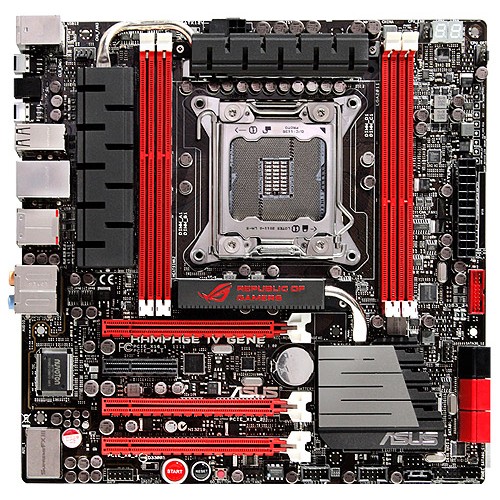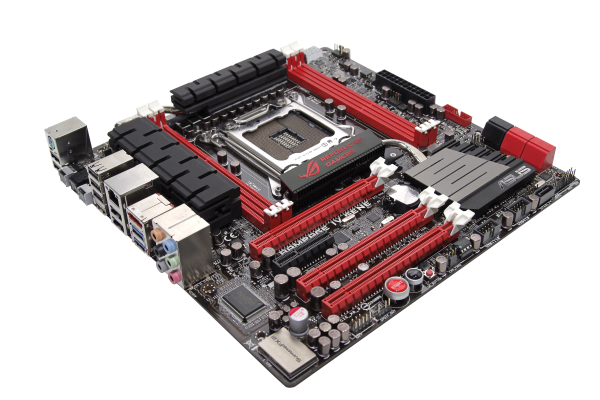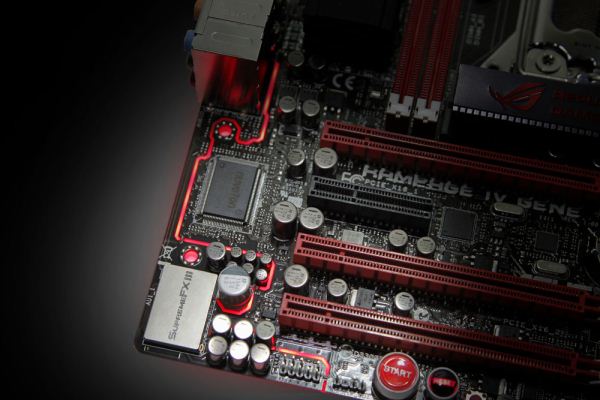ASUS Republic of Gamers and X79 ROG Review – Rampage IV Gene, Formula and Extreme
by Ian Cutress on August 3, 2012 1:00 PM EST- Posted in
- Motherboards
- Asus
- X79
- ROG
Rampage IV Gene Overview
When considering the Rampage IV Gene, it is hard to look past the fact that it is a micro ATX product. Typically for such a price, one would expect a full sized ATX product with all the bells and whistles. But given that we are dealing with the 2011 chipset, almost everything costs a pretty penny anyway, but I also discussed with ASUS their action on the Gene.
Despite the fact that it is a smaller board, it covers several primary markets – power users, small(er) form factor gamers and overclockers. ASUS were keen to stress to me to see the Gene not as a restricted regular ROG board but as the entry level ROG board. From that perspective then it comes to light that yes indeed, the Gene does satisfy a lot of the main criteria for gamers – dual GPU in slots 1 and 3 or 1 and 4 with a full length PCIe card in the middle slot if required. Compared to the Extreme, it also includes an enhanced audio solution.
With the Gene being mATX, we obviously have some restrictions – only four memory slots. But this is given that most gamers will not require more than 16GB of memory (given a typical 4x4 GB setup - the Gene does support 4x8GB). Despite this, we still get more SATA 6 Gbps ports, fully controllable fan headers, enhanced heatsink and heatpipe design for heat transferal and USB 3.0 at the back on top of all the ASUS ROG enabled software (listed later in the review).
Performance wise, all the ROG boards have an advantage over the other X79 boards we have tested in terms of CPU performance at stock, due to ASUS’ policy of applying the maximum turbo mode during any load. This means that with a normal X79 board, the 3960X CPU should run at 3.9 GHz during 1 and 2 threaded load, going down to 3.6 GHz at full load. The ASUS policy is ‘MultiCore Enhancement’, meaning users will get 3.9 GHz whatever the load, giving a 300 MHz improvement at full load.
Thus for the most part, the Gene does perform better than the other X79 boards we have tested. Against the other two ROG boards it does seem to be behind the Extreme and the Formula, but by no means is it a slouch. It performs well under pressure, and is indeed a good entry board for those under the ROG bandwagon. It is also worth mentioning that the Gene comes with a competitive 3-year warranty and qualifies in North America for ASUS Premium Service.
Visual Inspection

The ROG theme is relatively straight forward – red and black, with a little grey and silver if you have to. One thing which may immediately jump out is the size of the heatsinks. Covering the power delivery is a fairly substantial pair of heatsinks connected with a heatpipe. Just to the close proximity of everything in the socket area (note that ASUS always has extra chips to deal with power and overclocking et al. on board), users have the default Intel specifications to deal with on space. Some form of all-in-one liquid cooling system would be ideal here.
For fan headers, users will find one 4-pin to the top left of the socket, two 4-pin headers to the top right of the socket (one to the left of the two-digit debug, one to the right) and another just beside the 24-pin ATX power connector. The final header on board is 4-pin and found on the bottom of the board between the Reset button and the USB header.
Down the right hand side of the board, users will find that two-digit debug previously mentioned (useful for enthusiasts determining errors), the 24-pin ATX power connector, a USB 3.0 front panel header (ASMedia), and the SATA ports. Typically on X79 we have four SATA 3 Gbps and two SATA 6 Gbps from the chipset. Here on the Gene, ASUS are using two SATA 3 Gbps from the chipset (black), two SATA 6 Gbps from chipset (red) and two more SATA 6 Gbps from a controller (red, ASMedia). The other two 3 Gbps ports are found such that one is facing out of the board at the bottom (gray), and one provides the eSATA port on the IO panel.
Along the bottom of the board are our standard array of headers – front panel audio, USB, and also the BIOS chip. The Gene also includes power and reset buttons, useful for reviewers and overclockers. Also onboard is a Go Button, which allows overclockers to apply a set of values selected in the BIOS during system operation. Using such a button could be a help or a hindrance, based on the severity of the overclock and system stability, but it is still a feature ASUS have included.
Special notes should be said about the audio solution. ASUS have dug into their pockets to provide the Gene with a better-than-Realtek solution, in the SupremeFX III. This section of the board has two main features which set it apart from a lot of other standard boards on the market – the audio signaling has its own PCB layer for traces, helping reduce interference. The section is also shielded from interference through the board partitioning, as shown below:
The SupremeFX III solution is rated as having a 110dB SNR, compared to the majority of audio products today offering 108dB SNR or less (typically 92-98dB). As will be mentioned later in the review, this comes about due to the design and a 1500µF capacitor.
The PCIe configuration is designed to help those with more than one PCIe device – GPUs can be placed in any slot and still display video, giving access to other full length PCIe channels or the PCIe x1 slot as required. Ideal routing should allow GPUs in slots 1/3, or 1/4 if an additional card (RAID or PCIe SSD) is required.

Back panel mixes some old and the new – from left to right, we have a combination PS/2 port, two USB 2.0 (black), USB BIOS Flashback button (which I have tested and can confirm it works great), optical SPDIF output, ROG Connect, four USB 2.0 (black, white at bottom for USB Flashback/ROG Connect), Intel GbE, two more USB 2.0 (black), one eSATA 3 Gbps (red), two USB 3.0 (ASMedia, blue), and standard audio jacks.


















34 Comments
View All Comments
iamkyle - Friday, August 3, 2012 - link
Has anyone used the included utilities on these series of boards that can comment on their usefulness compared to some other well-known OCing utilities out there?Jambe - Friday, August 3, 2012 - link
"Here on the Gene, ASUS are using two SATA 3 Gbps from the chipset (black), two SATA 6 Gbps from chipset (red) and two more SATA 6 Gbps from a controller (black, ASMedia)."The ASMedia 6 Gbps ports are red, not black. It might also be worth pointing out that the outside cluster is the ASMedia set and the middle one is the Intel set.
IanCutress - Saturday, August 4, 2012 - link
Many thanks for pointing this out. In my reviews I do go down the right hand side in order, especially in that paragraph. 24000 words and the odd one sometimes goes astray!Ian
HisDivineOrder - Saturday, August 4, 2012 - link
Doesn't the OC Key have a Single DVI limitation? You say in your article, "As long as you've got DVI, you're fine," or something along those lines, but the reality is that most of the high end users now use dual DVI (or Displayport) for 2560x1600/1440. After all, what's the point of pimping out your drag racing ride with the highest of the high end and then shrug and say, "1920x1200/1080 for yous!"Soooo... the high end are not using the OC Key because the OC Key doesn't support what the high end users are doing.
http://rog.asus.com/forum/archive/index.php/t-1128...
Honestly, I think the OC Key is just one big wasted opportunity because of this. Anyone willing to fork over $450 on a motherboard, $500+ on a CPU, have 8 sticks of memory, have four GPU's...
You think they need just a single-DVI OC Key? It's really rather absurd. It might be true, but people who spend that scratch will probably need the superior bandwidth sooner rather than later.
IanCutress - Saturday, August 4, 2012 - link
OC Key is not designed for gamers. It is designed for extreme overclockers who are competing for scores, most likely also using sub-zero cooling (Dry Ice, Phase or LN2). I have used it on occasion for competitive overclocking, and also have seen it used in overclocking competitions.That is its usage scenario.
Ian
shuntian8099 - Saturday, August 4, 2012 - link
1; 1 wholesalenets,very good website: === http://www.aaaaoooo.co/en/index.phphttp://commonprosperity.org/
The website wholesale for many kinds of fashion shoes, like the nike, jordan, prada, also including the jeans, shirts, bags, hat and the decorations.
All the products are free shipping, and the the price is competitive, After the payment, can ship within short time.simpletrading@hotmail.com
We will give you a discount
WE ACCEPT PYAPAL PAYMENT
YOU MUST NOT MISS IT!!!
.’,”’,,’,.”,,’,”,.╱◥██◣”o’,”’,,田田”.”,,’,.
╭⌒╮╮ |田|⌒
田田│ ”,,’,.’,”’,,’,.” ╬╬╬╬╬╬╬╬╬╬╬╬╬╬╬╬╬╬e Good, best, authentic, http://commonprosperity.org/ ]]This site has a lot of what we want, you can go look, miss it you will feel a great pity ╮.’,”’,,’,.”,,’,”,. ╱◥██◣”o’,”’,,’,.”.”,,’,.
╭⌒╮⌒ |田| ⌒
田田│ ”,,’ ╬╬╬╬╬╬╬╬╬╬╬╬╬╬╬╬╬╬e Good, best, http://commonprosperity.org/]]This site has a lot of what we want, you can go look, miss it you will feel a great pity
shuntian8099 - Saturday, August 4, 2012 - link
We accept any form of payment.
http://commonprosperity.org/ )
S=h=0=x ==sh0es=4oUSD
J=0=r=d=a=n==sh0es=36USD
A=i=r==M=a=x=sh0es=39USD
C=0=a=c=h==b=a=g=36USD
S=u=n=g=l=a=s=s=15USD
simpletrading@hotmail.com
Finally (48 hours) time limit to buy.
LV Muffler $ 5.99
LV Bags $ 19.9
LV Wallet $ 6.55
Armani Glasses $ 5.99
LV Belt $ 6.9
simpletrading@hotmail.com
Buy addresses-
commonprosperity.org
╭⌒╮
∴★∵**☆.∴★∵**☆.∴★∵**☆.█████.::∴★∵**☆.∴★∵**☆.█田田█::
commonprosperity.org ╭⌒╮ ╭⌒╮
∴★∵**☆.∴★∵**☆.█田田█.∴★∵**☆.∴★∵**☆.█田█田█∴★∵**☆.∴★∵*
*☆.█田█田█.★∵**☆.∴★∵**☆.█████.*******************You
r satisfaction is our eternal pursuit!
Laststop311 - Saturday, August 4, 2012 - link
I have an m18x desktop replacement. Has a 4.1 Ghz on all 4 cores OC without using turbo, the i7-2960xm, 4x4GB 1866MHz RAM, Crossfire Radeon 6990m's with both with a healthy overclock.It chews through almost every game on my 27" dell ultrasharp external monitor at 2560x1440 at at least 45 fps soe more some less but almost ALWAYS at very min above 25-30. Once I get the money to change out the 6990m's with 7970m's in crossfire I'll be playing every game at 45+ fps at 2560x1440 and full yltra settings.
So don't sit there and tell me laptops suck for LAN partys. Because actually I can carry my m18x in a little carrier like it's a backpack and set up at the lan and be ready to go in a hurry.
And the funny part is the laptop pulls higher fps then a lot of my friends pc's and that's not even with the 6990's upgraded to 7970m's.
ALSO the r2 version of the m18x came with a new specially designed beefier heatsink set up for the XM processor that is triple the surface area but fits right in place. So I'll also be getting that much larger cpu heatsink to crank my OC from 4.1Ghz to 4.3-4.4 or so, basically a crazy killer speed demon laptop cpu
Laststop311 - Saturday, August 4, 2012 - link
Claro Halo has a very very nice clean headphone amp (Headphone output with TPA6120 AMP IC) that can drive up to 600 ohms like a champ.It has incredibly high quality stereo RCA outputs for a low line level signal to a high quality stereo receiver (hardly any cards have gold plated RCA outputs which is crucial for a high quality connection to a high end receiver.) As well as a 5.1 optical output. If you require 7.1 output you can get the add on XT card that plugs in a connector on the sound card for additional gold plated 7.1 analog outputs.
It also has 120dB s/n which is +2 better. It also has swappable OP-AMPS to customize the character of the sound exactly how you like it. You can also switch it to 32 ohm output mode from 300/600 ohm mode on the headphone amp output to adjust between huge full size cans and in ear monitors that are much more sensitive.
Uses C Media CMI8788 8 channel sound processor with full duplex 2 channel 24bit/192khz AK4396 DAC's and 24bit/192khz AK5385 ADC for recording.
Every input and output is gold plated.
Claro Halo is the best sound card hands down.
macforth - Saturday, August 4, 2012 - link
A very interesting read.......Thanks for that Ian.I have just bought an ROG, but it's the Maximus V Extreme..I am about to build a WC setup and run 690's in SLI.
The reason I chose the 1155 as against the 2011, is the cost of the top MB and top CPU (given the gaming world's belief that there's little gain), PCIe 3, and I don't need the abilities that the 2011 shines in. I more play games. And to be quite honest, to me ROG spells GAMER!
It's a while since I have seen any comparison of an ROG 2011 v 1155 just for games......and certainly not since the last proliferation of 1155's game to town.
Ahhhh it would be very very interesting!